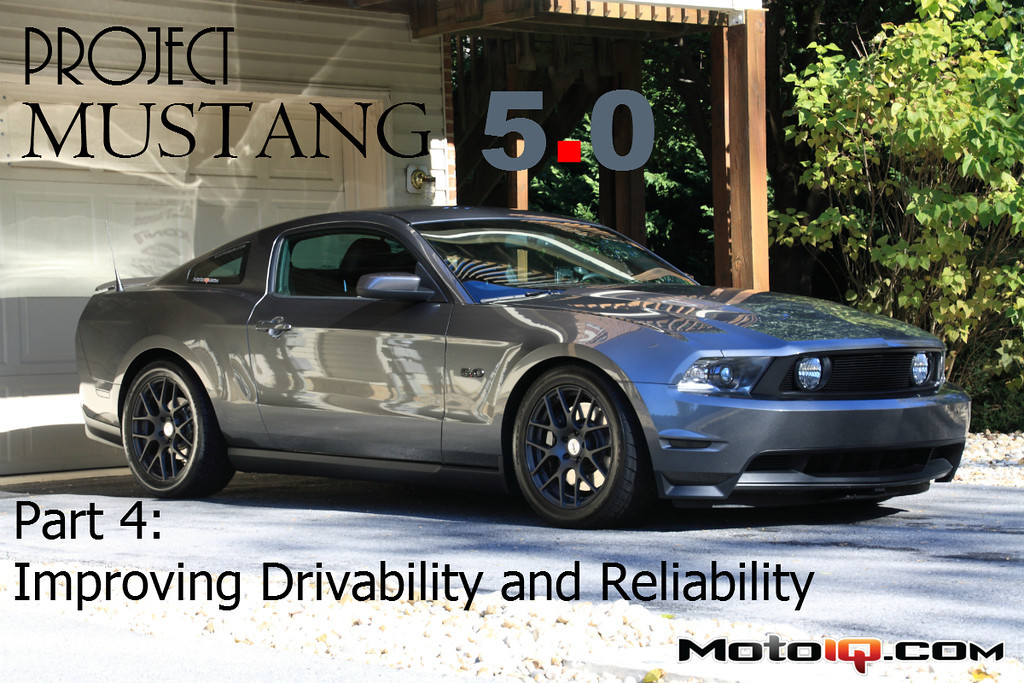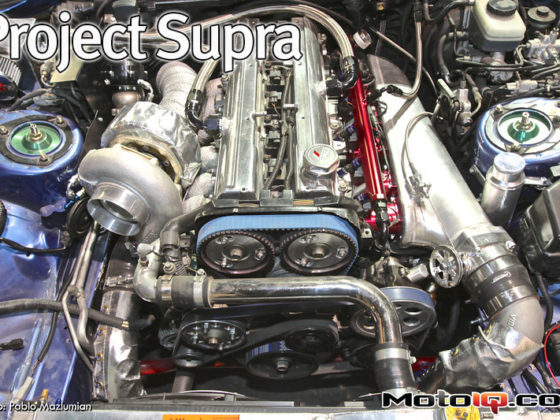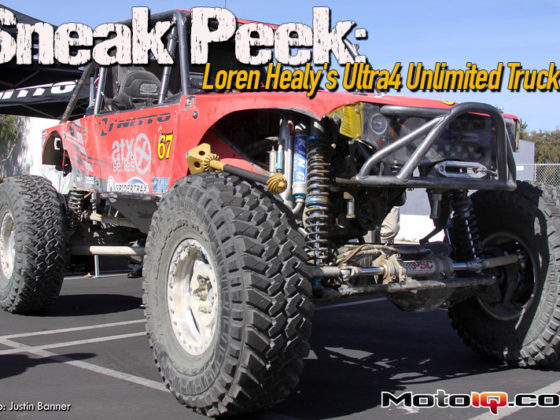,
The stock GT brakes, while larger in diameter than earlier year S197 Mustangs, were beginning to wear out much faster than I would’ve liked. Two and a half years of street driving and autocross had taken their toll on them. The front rotors were slightly warped, creating a pulsing in the brake pedal and vibration in the steering wheel when coming to a stop. Furthermore, the brake fluid had boiled at least once; it had leaked from underneath the master cylinder cap under the hood. Both of these problems are caused by excessive heat buildup.
There are several solutions to this, such as swapping to a two-piece rotor (two piece rotors don’t warp as easily), brake ducts (which are ineffective at the relatively low speeds of autocross), or going with an aftermarket “big brake kit” (bigger rotors equate to larger heat sinks). However, an even better (and less expensive) solution presented itself to me in the form of a friend selling a used set of OEM 4-piston Brembo brakes. These brakes are stock on ’07-12 GT500s, BOSS 302s, and GTs equipped with the Brembo package or “Track Pack,” like the white ’13 Project Mustang 5.0.
Using factory brake parts has a lot of advantages. The calipers and rotors simply bolt up with no modifications other than removing the small factory dust shield. The brake lines are 100% compatible, and the anti-lock braking system and master cylinders are already calibrated to work with it. The calipers are designed with daily driving in mind, so they have dust boots and anti-rattle pins in place for reliability. And since they are Brembo brakes, there are many, many different pads available.
 J&M’s brake lines are stainless steel coated with Teflon for protection from the elements and chafing. They have OEM-like brackets to facilitate an easy installation. We installed these both front and rear.
J&M’s brake lines are stainless steel coated with Teflon for protection from the elements and chafing. They have OEM-like brackets to facilitate an easy installation. We installed these both front and rear.Both “standard” Mustang GTs and those equipped with factory Brembo brakes use rubber brake lines. As part of this upgrade, I opted to swap the lines to stainless steel units from J&M parts. J&M’s brake lines are made up of several layers. An inner rubber layer holds the brake fluid. On top of that is a braided stainless steel layer that protects the rubber line beneath it and prevents the rubber line from expanding or “ballooning” when braking pressure is applied. A third layer of Teflon is on top of that. The Teflon layer prevents the elements from corroding or damaging the lines and helps prevent chafing. The lines also come equipped with brackets just like the OEM lines, so zip ties and other janky installation methods aren’t required.
 The Brembos bolt up with little trouble. All the fittings are the same, and the calipers use the factory bracket, as well. Mustangs are like LEGO sets; everything bolts right up. Yes, the rotors and calipers are little dirty. Race Car, not Show Car.
The Brembos bolt up with little trouble. All the fittings are the same, and the calipers use the factory bracket, as well. Mustangs are like LEGO sets; everything bolts right up. Yes, the rotors and calipers are little dirty. Race Car, not Show Car.As another solution to the boiling brake fluid, I opted to switch out the factory DOT3 brake fluid for some DOT4 ATE Super Blue brake fluid. This stuff is now illegal in the United States due to some obscure federal law from the ‘70s that states that all brake fluid must be clear or yellow. I literally got the last liter of this stuff in the entire state of Maryland. I’m such a rebel.
Whereas standard DOT3 brake fluid has a dry boiling point of only 205°C, ATE Super Blue has a dry boiling point of 280°C. This higher boiling point, coupled with the larger rotor diameter and thus larger heat sink, should help alleviate or eliminate my brake fluid boiling issues. The rotors above are Centric pieces that are even better than OEM. For brake pads, I used a set of Hawk HPSes, which have better resistance to fade than stock-compound pads, though they are a bit dodgy below 40°F until they’re warmed up, squeal like a stuck pig when coming to a stop, and put out a lot of brake dust. Because RACE CAR.

After installing the brakes, lines, fluid, and bleeding the system, we bolted everything back up and went for a test drive. The difference was immediately apparent. The stainless lines had a much lower expansion coefficient, so more of the pedal pressure was transferred directly to the brake pistons. The increased surface area of the pads and increased rotor diameter all combined to stop the car RIGHT NOW. In fact, the first time I stood on the brakes, the car stopped so fast it made me dizzy. It actually took me a couple weeks of driving to get used to the new brakes!
 The new brakes fit perfectly (but barely) behind the 18” TSW Nurburgrings used for driving on the street. At 14.0”, those rotors are HUGE.
The new brakes fit perfectly (but barely) behind the 18” TSW Nurburgrings used for driving on the street. At 14.0”, those rotors are HUGE.Fortunately, the 18×8” TSW wheels I use for street driving fit perfectly over the new, larger brakes (the Grey Project Mustang doesn’t roll on dubs). Unfortunately, the American Muscle 18×10” wheels used for racing presented a problem. Although the wheels technically cleared the huge Brembo calipers, the stick-on wheel weights did not. So, I had to remove those wheel weights and have the wheels static balanced instead of dynamic balanced. This allowed me to put wheel weights only on the back of the wheels. The result is a slightly less smooth ride at highway speeds, but since these wheels are only used for racing, that’s a tradeoff I’m willing to make.
 This picture shows the wheel weights on the American Muscle 18” wheels hitting the caliper. Static balancing the tires with wheel weights only on the inside of the wheel fixed this issue.
This picture shows the wheel weights on the American Muscle 18” wheels hitting the caliper. Static balancing the tires with wheel weights only on the inside of the wheel fixed this issue.


